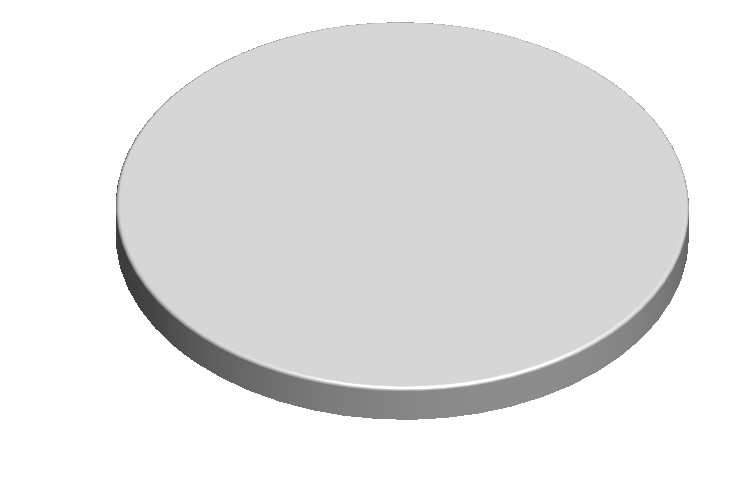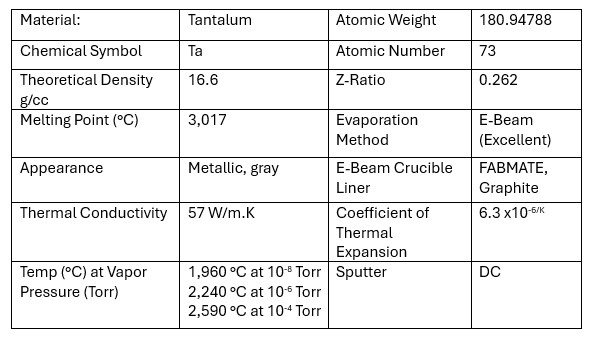Ideal Vacuum Circular Magnetron Sputtering Targets, TANTALUM - Ta Sputtering Target, 3'' Diameter x 0.25" Thick, 99.95 Percent Purity.
Ideal Vacuum Products, LLC.
This product is a circular magnetron TANTALUM -Ta sputtering target, with a 3'' diameter x 0.25" thickness. It is 99.95% pure.
We use a very competitive pricing strategy to ensure you receive the highest quality products at the best possible value, giving you both affordability and excellence in every purchase. We offer huge discounts to every customer, customers who place bulk orders will enjoy huge savings. We stock huge quantities of our products to give our customers guaranteed same day shipping after placing an order. This short lead time is loved by all our customers who look to manage their cash flow with quicker turnaround times. Our regular customers can maintain lower inventory levels, decreasing storage costs and minimizing the risk of obsolescence. Buying from Ideal Vacuum means a customer receives their product more quickly, enhancing satisfaction and meeting their urgent needs. This also enables our customers to stay ahead of their competition by quickly adapting to new trends and demands.
TANTALUM -Ta
Tantalum (Ta) sputtering targets are widely used for thin-film deposition in various high-tech industries due to tantalum’s excellent mechanical, chemical, and electrical properties. Here’s a concise summary of tantalum sputtering targets in thin films:
1. Material Properties:
High Melting Point: Tantalum has an exceptionally high melting point (~3017 °C), making it stable under high-temperature conditions.
Corrosion Resistance: Tantalum is chemically inert and highly resistant to corrosion by acids, making it ideal for protective and barrier layers.
Ductility and Strength: Tantalum is both strong and ductile, allowing for the formation of durable thin films.
Electrical Conductivity: Tantalum is a conductive material, which makes it suitable for use in electrical and microelectronic applications.
2. Deposition Methods:
DC Sputtering: Since tantalum is conductive, DC sputtering is often used for thin-film deposition, which allows for a higher deposition rate compared to RF sputtering.
RF Sputtering: RF sputtering can also be used if necessary, particularly in complex deposition setups, but DC sputtering is more common for tantalum.
Reactive Sputtering: Tantalum is frequently used in reactive sputtering to form tantalum compounds such as tantalum pentoxide (Ta2O5 ) for specific applications.
3. Applications:
Microelectronics: Tantalum is widely used in semiconductor and integrated circuit manufacturing. Thin tantalum films are employed as barrier layers in copper interconnects to prevent copper diffusion into silicon or other layers.
Capacitors: Tantalum thin films are used in tantalum capacitors, where they provide high capacitance and reliability, especially in small devices.
Protective Coatings: Due to its excellent corrosion resistance, tantalum is used as a protective coating in harsh chemical environments, including in the chemical processing industry and biomedical implants.
Optical Coatings: Tantalum is used in some optical coatings for its mechanical strength and durability, although its primary use in optics comes from compounds like Ta2O5 .
4. Film Properties:
Mechanical Strength: Tantalum thin films provide strong, wear-resistant coatings, useful in protective applications.
Corrosion and Oxidation Resistance: Tantalum films resist oxidation and corrosion, making them suitable for high-performance environments.
Barrier Layers: Tantalum is frequently used as a diffusion barrier in microelectronics to prevent metal migration (e.g., copper) and enhance device longevity.
Electrical Conductivity: Tantalum’s conductivity makes it ideal for use in electronic circuits and components, such as resistors, electrodes, and thin-film transistors.
5. Reactive Deposition:
Tantalum Pentoxide (Ta2O5 ): Tantalum is often sputtered in a reactive environment with oxygen to form Ta2O5 thin films, which are used in optical coatings and dielectric layers due to their high dielectric constant and optical transparency.
6. Challenges:
Target Poisoning: In reactive sputtering processes, target poisoning can occur when non-metallic compounds (e.g., oxides) form on the tantalum target, reducing the sputtering efficiency.
Stress in Films: Tantalum films can develop internal stress during deposition, which may affect film adhesion and performance.
Summary:
Tantalum (Ta) sputtering targets are primarily used in microelectronics, protective coatings, and capacitors due to their high corrosion resistance, conductivity, and mechanical durability. Tantalum thin films are crucial for barrier layers in integrated circuits, diffusion barriers in copper interconnects, and in capacitor electrodes. DC sputtering is typically used for efficient deposition, while reactive sputtering can form tantalum compounds like Ta2O5 , which are widely used in optical coatings and dielectrics.

 Notes:
Notes:
Metallic or elastomer backing plate bonding is recommended for all dielectric target materials because these materials have characteristics which are not amenable to sputtering, such as, brittleness and low thermal conductivity. These targets are most susceptible to thermal shock due to their low thermal conductivity and hence, may require specific power ramp up and ramp down procedures during start up and shut down steps.
|